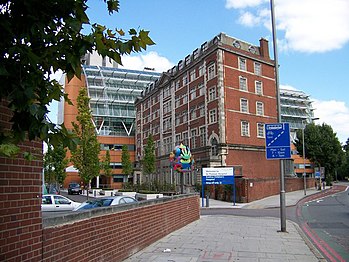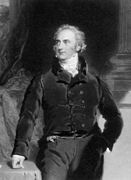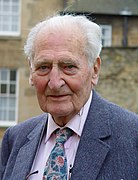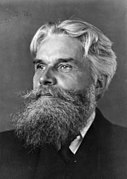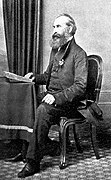GKT School of Medical Education
 | |
| Type | Medical school |
|---|---|
| Established | 1173 (St Thomas's hospital as 'teaching hospital') 1550 (St Thomas's Hospital Medical School) 1909 (King's College Hospital Medical School) 1982 (United Medical and Dental Schools of Guy's and St Thomas' Hospitals) 1998 (Guy's, King's and St Thomas' School of Medicine) 2005 (King's College London School of Medicine) 2015 (King’s College London GKT School of Medical Education ) |
| Dean | Professor Stuart Carney |
Academic staff | 315 |
| Students | 2200[1] |
| Location | , |
| Campus | Guy's Campus |
| Colours | Navy blue, Gold, Purple, White, Red |
| Affiliations | King's College London University of London |
| Website | www.kcl.ac.uk/schools/medicine |
 | |
King's College London GKT School of Medical Education (abbreviated: GKT) is the medical school of King's College London. It is the biggest healthcare training facility in Europe.[2] The school has campuses at three institutions, Guy's Hospital (Southwark), King's College Hospital (Denmark Hill) and St Thomas' Hospital (Lambeth) in London. The school in its current guise was formed following a merger with the United Medical and Dental Schools of Guy's and St Thomas' Hospitals on 1 August 1998.[3]
The medical school as a whole is the largest in Europe. It has an annual intake of around 335 places on the standard MBBS Programme, 50 places on the Extended Medical Degree Programme (EMDP)[4] and 28 places on the Graduate/Professional Entry Programme (GPEP).[5] It receives more applications for medicine than any other UK medical school and as of 2016 applicants were required to sit the UKCAT admission test.
The medical school is ranked 8th in the world, as adjudged by Times Higher Education (THE) in its World University Rankings 2015-2016 by subject (Clinical, Pre-clinical and Health Results), commenting that "...While the overall strength of these countries has dipped, some of their institutions have moved against the tide. One of these is King’s College London, which makes its debut in the top 10 (eighth)."[6] As to QS World University Rankings (Medicine) 2016, the school is ranked 21st globally.[7] The school is ranked 21st in the UK by the Complete University Guide 2016.[8]
Name
The School was named the GKT School of Medicine between 1998 and 2005. However, due to confusion over the official name of the institute, especially with regards to research emerging from the university, it was rebranded as the King's College London School of Medicine and Dentistry at Guy's, King's College and St Thomas' Hospitals.
In 2015, to reflect the strong history of the multiple institutions that comprise the medical school, the School once again rebranded as the King’s College London GKT School of Medical Education.[1]
History


The hospitals associated with King's College London GKT School of Medical Education, i.e., Guy's Hospital, King's College Hospital and St Thomas' Hospital (hence the GKT name and abbreviation), are: "amongst the oldest hospitals in the world, having endured the Black Death, the plague, the War of the Roses, the Great Fire of London, the Blitz and over 60 years of NHS reforms."[9]
Of the three hospitals, St Thomas' Hospital is the oldest and was founded in 1173 but whose roots can be traced to the establishment of St Mary Overie Priory in 1106.[10][11][12] Sir Thomas Guy, a governor of St Thomas', founded Guy's Hospital in 1721 as a place to treat 'incurables' discharged from St Thomas'.[13]
St Thomas's Hospital Medical School was founded in 1550 and was sited across St Thomas' Hospital and Guy's Hospital. In 1769 it was decided that Guy's would teach mainly medical subjects, whereas St Thomas' would focus on surgery[14] and the joint teaching institution was generally known as The Borough Hospitals. However, a dispute between the two hospitals regarding the successor to Sir Astley Cooper resulted in Guy's Hospital establishing its own medical school in 1825. After this, students of surgeons attended operations at both hospitals until 1836. A riot between students of the two hospitals broke out in the operating theatre at St. Thomas's in 1836 which ended the arrangement.[15] St Thomas's Hospital Medical School and Guy's Hospital Medical School were two of the oldest and most prestigious medical schools in the UK.
In 1982 the two medical schools decided to merge and formed the United Medical and Dental Schools of Guy's and St Thomas' Hospitals, more commonly known as UMDS. It was enlarged in 1983 when the Royal Dental Hospital of London School of Dental Surgery merged with Guy's Hospital Dental School, and again in 1985 with the addition of the Postgraduate Institute of Dermatology.[16]
Initially students of UMDS were allocated to one of the two campuses, with most preclinical teaching and all clinical teaching being separate. With the intake of 1989, students ceased being allocated in this way, and teaching for all students was divided between the campuses and their peripheral hospitals.
Discussions between King's College London (which had trained medical students since it was established and founded its own hospital, King's College Hospital, in 1840) and UMDS regarding a further merger began in 1992. UMDS was subsequently absorbed into King's College London on 1 August 1998,[3] forming the Guy's, King's and St Thomas' School of Medicine, more commonly known as GKT.[17] In 2005, the entity was rebranded King's College London School of Medicine and Dentistry at Guy's, King's College and St Thomas' Hospitals, also known as KCLMS. However it is still widely known as GKT amongst current students, graduates and consultants who consider themselves affiliated to the hospitals rather than the university.
In 2005 the dental school became the Dental Institute and the remainder was renamed the King's College School of Medicine. The dean, Robert Lechler, oversees the running of both the Medical and Dental schools, as well as the School of Biomedical Sciences (all three were formerly regarded as GKT before the rebranding).
Before the start of the 2010/11 academic year, Physiotherapy became a part of the School of Medicine, having previously been run by the School of Biomedical and Health Sciences.
Hospitals
King's College London GKT School of Medical Education is associated with the following hospitals:
- Guy's Hospital
- St Thomas' Hospital
- King's College Hospital
- Maudsley Hospital
- Ladywell Unit based at University Hospital Lewisham
- Bethlem Royal Hospital
- Evelina London Children's Hospital
Campuses
Guy's Campus
Guy's Campus is situated close to London Bridge and the Shard on the South Bank of the Thames and is home to the School of Biomedical Sciences (also at the Waterloo Campus), the Dental Institute and the School of Medicine.[18]
Thomas Guy, the founder and benefactor of Guy's Hospital established in 1721 in the London Borough of Southwark, was a wealthy bookseller and also a governor of the nearby St Thomas' Hospital. He lies buried in the vault beneath the eighteenth-century chapel at Guy's. Silk-merchant William Hunt was a later benefactor who gave money in the early nineteenth century to build Hunt's House. The original Hunt’s House was closed due to war damage, and was eventually demolished as part of campus development. Today this is the site of New Hunt's House, which was opened in September 1999 following the merger of UMDS and King’s.[19] The Henriette Raphael building, constructed in 1902, and the Gordon Museum are also located on this campus. In addition, the Hodgkin building, Shepherd's House and Guy's chapel are prominent buildings within the campus. The Students' Union centre at Guy's is situated in Boland House. Guy's Campus is located opposite the Old Operating Theatre Museum, which was part of old St Thomas Hospital in Southwark.
The nearest Underground stations are London Bridge and Borough.
It is also home to Guy's Bar, and Thomas Guy Club, two drinking establishments.
The Colonnade

The Colonnade is also part of the original Guy's Hospital. It was built with two courtyards on either side.[19] A round-hooded Portland stone alcove with a figure sitting inside is located at the eastern courtyard of the Colonnade. The alcove was originally part of, and is one of the surviving fragments of the old London Bridge that was demolished in 1831.[19][20] The alcove was brought to the hospital in 1861, and was re-erected within the eastern internal court in 1926.[20] The alcove now houses the statue of John Keats, an English Romantic poet who studied at Guy's Hospital from 1815 to 1816 to become an apothecary. The statue displayed at the western courtyard on the other side of the Colonnade is that of William Morris, 1st Viscount Nuffield, another benefactor of Guy's Hospital.[19] The front courtyard, named the General Court, was later built in 1738,[20] and the part of the Georgian complex was completed in 1780.[21] A brass statue of Thomas Guy by Peter Scheemakers stands in the centre of the General Court,[19][22] upon a pedestal with bas-reliefs of "Christ Healing the Sick" and the "Good Samaritan".[22][23]
Hodgkin Building

The Hodgkin Building was named after Thomas Hodgkin, the demonstrator of morbid anatomy (anatomical pathology as it is now called), the former curator of the museum at Guy’s Hospital Medical School and best known for the first account of Hodgkin's disease. The building is the original medical school building of Guy’s Hospital.[19]
The entrance hall and corridor of the Hodgkin Building displays busts of King’s alumni and benefactors, including Thomas Addison, William Babington, Golding Bird, Richard Bright, Astley Cooper and Richard Mead.[19] The Hodgkin Building currently houses lecture theatres, teaching laboratories, dissecting rooms, museums (Gordon Museum of Pathology and Museum of Life Sciences) and research centres. The original medical school library, Wills Library, is also located on the ground floor of the building.[19]
Henriette Raphael House
Henriette Raphael House was opened in 1902.[19] It is the first purpose built nurses' home in London.[19][24] The house was named after Henriette Raphael, and was funded by donations from her merchant banker husband Henry Louis Raphael, and her sons Walter Raphael and barrister Herbert Raphael.[19][24]
Guy's Chapel
The Grade II* listed Guy's Chapel is one of the oldest parts of the original hospital. It was finished in 1780 and features Victorian stained glass windows and mosaic murals.[19] The chapel is in the centre block of the west wing of the original Guy's Hospital.[20] There is a white marble monument to Thomas Guy by John Bacon inside the main door of the chapel.[19][23] The monument was erected in 1779, and is set in a semicircular-arched surround made of green marble.[20] The chapel houses the tomb of Thomas Guy, and is the resting place of English surgeon and anatomist Sir Astley Cooper.[21] The coffin-shaped stone tomb of Guy where his remains rest is located in the crypt beneath the chapel.[19][20] The chapel also contains memorials to hospital's benefactors and members of the hospital staff.[20]
St Thomas' Campus

The St Thomas' Campus in the London Borough of Lambeth, facing the Houses of Parliament across the Thames, houses parts of the School of Medicine and the Dental Institute. The Florence Nightingale Museum is also located here.[25] The museum is dedicated to Florence Nightingale, the founder of the Nightingale Training School of St Thomas' Hospital (now King's Florence Nightingale Faculty of Nursing and Midwifery). St Thomas' Hospital became part of King's College London School of Medicine in 1998. The St Thomas' Hospital and Campus were named after St Thomas Becket.[26] The Department of Twin Research (TwinsUk), King's College London is located in St. Thomas' Hospital.
The nearest Underground station is Westminster.
Denmark Hill Campus
Denmark Hill Campus is situated in south London near the borders of the London Borough of Lambeth and the London Borough of Southwark in Camberwell and is the only campus not situated on the River Thames. The campus consists of King's College Hospital, the Maudsley Hospital and the Institute of Psychiatry, Psychology and Neuroscience (IoPPN). In addition to the Institute of Psychiatry, Psychology and Neuroscience, parts of the Dental Institute and School of Medicine, and a large hall of residence, King's College Hall, are situated here. Other buildings include the campus library known as the Weston Education Centre (WEC), the James Black Centre, the Rayne Institute (haemato-oncology) and the Cicely Saunders Institute (palliative care), the wold's first purpose-built institute for palliative care[27][28]
The Maurice Wohl Clinical Neuroscience Institute was opened by the Princess Royal in 2015 at the Denmark Hill Campus.[29] It is named after British philanthropist Maurice Wohl, who had a long association with King’s and supported many medical projects.[30]
The nearest Overground station is Denmark Hill.
Admissions
King's College London, generally in 2005, is the sixth-most difficult UK university to gain admission to the, as ranked as Sunday Times.[31] A freedom-of-information request in 2015 revealed that for every 1,764 applications that School of Medical Education received, only 39 offers were made thereby resulting in an offer rate of just 2.2%; Nursery & Midwifery, Physiotherapy and Clinical Dentistry also had one of the lowest offer rates of 14%, 16% and 17%, respectively.[32]
Graduation

Also see Graduation Dress of King's College London
Graduation ceremonies for School of Medical Education are normally held in June or July (summer).[34] During summer graduation, the graduation ceremonies are held in Southwark Cathedral; this is owing to St Thomas's Medical School roots that could be traced to St Mary Overie Priory.[33] For those who happen to finish during January (winter), graduands could opt for attending the graduation ceremonies held in the Barbican Centre.[34]
Research
The School's research excellence is recognised worldwide and the 2008 Research Assessment Exercise confirmed King's as one of the top two universities in the UK for health research strength. Around 70 percent of health science submissions from King's were ranked in the top six within the UK.
Currently, the School hosts six MRC Centres,[35]
- MRC-Asthma UK Centre in Allergic Mechanisms of Asthma
- MRC Centre for Developmental Neurobiology
- MRC Centre for Neurodegenerative Research
- MRC Centre for Social Genetic and Developmental Psychiatry
- MRC Centre for Transplantation
- MRC-HPA Centre for Environment and Health (awarded in 2009[36] in collaboration with Imperial College London)
- MRC National Institute for Medical Research (MRC NIMR) including the MRC Biomedical NMR Centre (planned to move to the new Francis Crick Institute in 2015, a partnership between the MRC, Cancer Research UK, Imperial College London, King's College London, the Wellcome Trust and University College London)[37]
The two MRC Centres in Transplantation and the Allergic Mechanisms of Asthma in 2008 alone were awarded 'Centre of Excellence' status by the British Heart Foundation with funding of £9 million and a £4 million Breakthrough Breast Cancer Unit was opened in 2009.[38]
The School is also host to its own 'Centre of Medical Law and Ethics', the first of its kind in the UK,[39] and in March 2009, the school was accredited as an Academic health science centre, one of only five in the UK.[40]
Sports teams
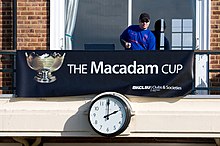
Like other medical schools in the UK, GKT has its own sports teams which compete in various student sports leagues and tournaments.
Like most other universities in London GKT sports teams take part in the BUCS leagues and cups and the University of London Union leagues and cups. The GKT teams also take part in the United Hospitals Cup, which is a sporting competition played between the medical, dental and veterinary schools of London in all sports. The two most popular and biggest of the competitions include the United Hospitals Bumps (rowing) and the men's rugby.
GKT has a fierce sporting rivalry with King's College London. This rivalry led to the founding of the Macadam Cup in 2004, which pits GKT and KCL sports teams against each other. The championship is named in honour of Sir Ivison Macadam, an alumnus of King's. So far in Macadam Cup's history, the GKT Team has the most number of wins.
Notable alumni, academics and staff
- Recep Akdağ, Turkish Health Minister
- Eric Anson, New Zealand's first specialist anaesthetist
- Thomas Armitage, British physician and founder of the Royal National Institute of Blind People
- William Bowman, ophthalmic surgeon, helped found Ophthalmological Society of the United Kingdom
- Sir James Black, Nobel Prize laureate for Medicine in 1988 for work leading to the development of propranolol and cimetidine
- William Bowman, ophthalmic surgeon, helped found Ophthalmological Society of the United Kingdom
- Richard Bright, discoverer of Bright's disease
- Russell Brock, Baron Brock, pioneering cardiothoracic surgeon
- Sir Astley Cooper, discoverer of the Cooper's ligaments of the breasts
- John Leonard Dawson, Serjeant Surgeon to the Royal Household of the United Kingdom
- Richard Doll, epidemiologist and physiologist; established link between smoking and cancer
- Havelock Ellis, physician, sexual psychologist and social reformer
- Reita Faria, Indian model and Miss World 1966
- William Fergusson, surgeon who introduced the practice of conservative amputation
- David Ferrier, pioneering experimental neurologist
- Abraham Pineo Gesner, surgeon and inventor of kerosene refining
- John Hilton, great anatomist and surgeon
- Thomas Hodgkin, discoverer of Hodgkin's lymphoma
- Sir Frederick Hopkins, discoverer of vitamins
- Takaki Kanehiro, Japanese naval doctor, first person to discover the link between beriberi and diet
- John Keats, writer
- Joseph Lister, pioneer of aseptic surgery
- W. Somerset Maugham, playwright, novelist, short story writer
- Humphry Osmond, psychiatrist who worked with psychedelic drugs and coined the term
- David Owen, Labour Foreign Secretary and founder of the Social Democratic Party
- Sir Alfred Poland, the first to describe Poland syndrome
- Dame Cecily Saunders, nurse, physician and social worker who developed the concept of the hospice and was a pioneer of palliative care
- Audrey Smith, cryobiologist who discovered the use of glycerol to protect human red blood cells during freezing
- Jeffrey Tate, conductor
- Max Theiler, virologist, awarded the 1951 Nobel Prize in Physiology or Medicine for developing a vaccine for yellow fever
- Sheo Bhagwan Tibrewal, Orthopedic surgeon and Padma Shri awardee
- Robert Bentley Todd, known for discovering and describing the condition postictal paralysis now known as Todd's palsy
- Gerard Folliott Vaughan, UK psychiatrist, who became a politician and minister of state during Margaret Thatcher's government
- Sir Samuel Wilks, pathologist
- Claire Windsor, wife of the Earl of Ulster and physician by profession
- Fiona Wood AM, plastic surgeon, Australian of the Year 2005
References
- ^ a b http://www.kcl.ac.uk/lsm/education/meded/about/index.aspx
- ^ http://www.bestcollegereviews.org/features/the-30-most-influential-colleges-and-universities-of-the-past-century/
- ^ a b "No. 55085". The London Gazette. 1 April 1998.
- ^ https://www.kcl.ac.uk/prospectus/undergraduate/emdp
- ^ "Medicine Graduate/Professional Entry Programme". kcl.ac.uk.
- ^ "World University Rankings 2015-2016 by subject: clinical, pre-clinical and health results". Times Higher Education World University Rankings. Retrieved 2016-07-24.
- ^ "QS World University Rankings by Subject 2016 - Medicine". QS Top Universities. Retrieved 2016-07-24.
- ^ "Rankings". Complete University Guide. Retrieved 16 May 2015.
- ^ "A history of Guy's, King's and St. Thomas' hospitals from 1649 to 2009: 360 Years of innovation in science and surgery". International Journal of Surgery. 9: 414–427. 2011. doi:10.1016/j.ijsu.2011.04.002.
- ^ "The Foundation of St Thomas's" (PDF). p. 1.
- ^ "A Chronology of State Medicine, Public Health, Welfare and Related Services in Britain 1066-1999" (PDF). p. 11.
- ^ "Our history".
- ^ "Guy's Hopital Medical School:Records".
- ^ http://www.qaa.ac.uk/reviews/reports/institutional/heqc/UnitedMedGuysStThomas_QAG369.asp
- ^ "Aleph main menu". kcl.ac.uk.
- ^ "Aleph main menu". kcl.ac.uk.
- ^ "St Thomas's Hospital Medical School Records". AIM25.
- ^ "Guy's Campus". King's College London. Retrieved 21 January 2013.
- ^ a b c d e f g h i j k l m n "Guys Campus Tour" (PDF). King's College London. Retrieved 30 December 2015.
- ^ a b c d e f g Roberts, Howard; Godfrey, Walter H (1950). Survey of London: Volume 22, Bankside (The Parishes of St. Saviour and Christchurch Southwark). London County Council. pp. 36–42. Retrieved 7 February 2016.
- ^ a b "The Guy's Chapel". King's College London. Retrieved 31 December 2015.
- ^ a b Fry, Herbert (1880). London in 1880: Illustrated with bird's-eye views of the principal streets. Scribner, Welford, and Co. p. 242. ISBN 9785870751627. Retrieved 7 February 2016.
- ^ a b "Query Club". The Sydney Mail. 24 April 1935. Retrieved 7 February 2016.
- ^ a b "Memorial: Entrance to the Henriette Raphael building". London Remembers. Retrieved 7 February 2016.
- ^ "St Thomas' Campus". King's College London. Retrieved 21 January 2013.
- ^ "The Foundation of St Thomas's" (PDF). p. 1.
- ^ "Denmark Hill Campus". King's College London. Retrieved 21 January 2013.
- ^ http://www.kcl.ac.uk/lsm/research/divisions/cicelysaunders/index.aspx
- ^ "HRH The Princess Royal opens one of the world's leading neuroscience institutes". King's College London. Retrieved 21 November 2015.
- ^ "King's awarded £10m for world-leading Hub for Neuropsychiatry Imaging Research and Therapeutics". Science Business. Retrieved 21 November 2015.
- ^ Coates, Sam; Elliott, Francis; Watson, Roland. "The UCAS points system". The Sunday Times University Guide 2005. London. Retrieved 30 July 2006.
- ^ FOI 16715 Response
- ^ a b "Venue Information".
- ^ a b "Locations". Retrieved 29 August 2009.
- ^ http://www.kcl.ac.uk/research/mrc.html
- ^ http://www.kcl.ac.uk/news/news_details.php?year=2009&news_id=1086
- ^ "Press release: £250 million commitment to UKCMRI". MRC National Institute for Medical Research. 26 March 2010. Retrieved 12 August 2010.
- ^ "King's College London - Faculty of Life Sciences & Medicine". kcl.ac.uk.
- ^ "King's College London - The Dickson Poon School of Law". kcl.ac.uk.
- ^ KCL Medical Prospectus 2010
External links
- King's College London School of Medicine
- GKT Medical Students' Association (MSA)
- King's College London School of Medicine student lists
- King's College London School of Medicine military personnel,1914-1918







